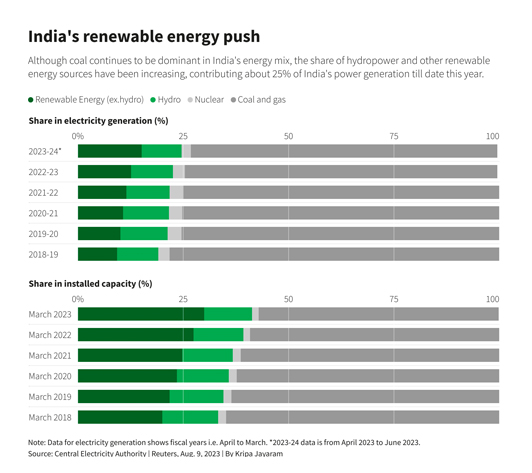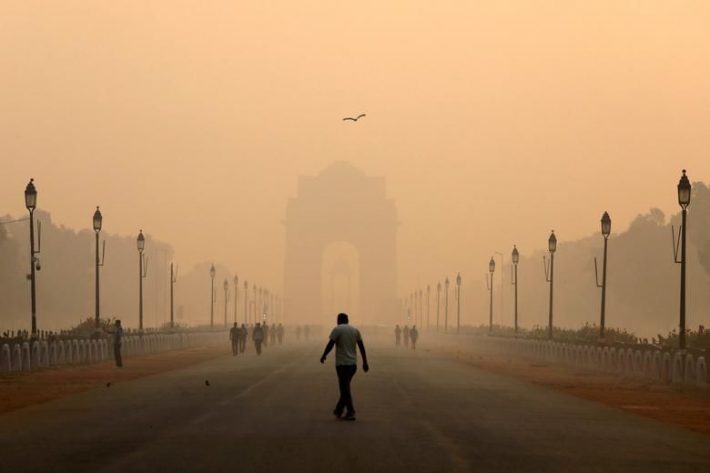India, the world’s third largest emitter of greenhouse gases, saw a faster-than-expected fall in emissions as it embraced renewables and expanded its green cover, officials say.
The rate of India’s emissions intensity – the total amount of greenhouse gases emitted for every unit increase of gross domestic product (GDP) – fell by 33% from 2005 to 2019, officials privy to the latest assessments made for submission to the United Nations said.
“There is continuous reduction in the emission intensity of the Indian economy, which shows the country has been able to completely decouple its economic growth from greenhouse gas emissions,” one official said.
Also on AF: China, US, India Face Climate Change Debt-Cost Time Bomb
India’s average rate of reduction in emissions increased to 3% annually between 2016-2019, from just about 1.5% in the 2014-2016 period.
It was the fastest reduction so far, and was largely attributable to the government’s push towards renewables, even as fossil fuel continues to dominate the energy mix.
The progress made on reducing emissions intensity should help India avert pressure by developed nations to stop using coal, a second official claimed.
This official said a substantial increase in forest cover and schemes promoting non-fossil generation and targeting emissions in industrial, automotive and energy sectors has led to the sharp reduction in India’s emissions intensity.
As of 2019, forests and trees covered 24.56%, or 80.73 million hectares, of India.
Also on AF: India Emits Record CO2 in Fastest Power Output Rise in 33 Years
Renewables in focus
The report’s findings show India is well on its way to meet a commitment to the United Nations Convention on Climate Change (UNFCCC), to reduce emissions intensity by 45% from the 2005 level by 2030.
The report, prepared for the Third National Communication (TNC) to UNFCCC, is yet to be ratified by the federal cabinet. Many countries are preparing their TNC to report their efforts to mitigate emissions.
Recently, India has also been trying to promote green hydrogen, manufactured by splitting water molecules using renewable energy.
Central Electricity Authority data shows that non-fossil fuel-based power – including hydro, nuclear and renewable energy – accounted for 25.3% of India’s total power generation in the fiscal year that ended in March, up from 24.6% three years earlier.

Thermal power stations still provide 73% of the electricity consumed, down from about 75% in 2019.
The Group of 20 (G20) major economies failed twice last month to agree on phasing out the use of fossil fuels and on setting concrete targets to cut emissions.
Developing countries including India are resisting higher emission reduction targets, arguing that industrialised nations’ unfettered use of fossil fuels have depleted resources.
Also on AF: India Calls on Rich Nations to Deliver $100bn Climate Fund
Indonesia capital ‘world’s most polluted’
Meanwhile, Indonesia’s capital Jakarta topped the list as the world’s most polluted city on Wednesday, having consistently ranked among the 10 most polluted cities globally since May.
Jakarta, which has a population of over 10 million, registers unhealthy air pollution levels nearly every day, data by Swiss air quality technology company IQAir showed.
“So many children are sick with the same complaints and symptoms such as coughs and cold,” Jakarta resident Rizky Putra said, lamenting that the worsening air quality was putting his children’s health at risk.
“I think the situation is very worrying.”
Solution in ‘changing capital’
Jakarta residents have long complained of toxic air from chronic traffic, industrial smoke and coal-fired power plants. Some of them launched and won a civil lawsuit in 2021 demanding the government take action to control air pollution.

The court at the time ruled President Joko Widodo must establish national air quality standards to protect human health, and the health minister and Jakarta governor must devise strategies to control air pollution.
Still, Nathan Roestandy, co-founder of air quality app Nafas Indonesia, said the pollution level has continued to deteriorate.
“We take more than 20,000 breaths a day. If we take in polluted air everyday, (it could lead to) respiratory and pulmonary diseases, even asthma. It can affect cognitive development of children or even mental health.”
Asked about Jakarta’s pollution problem on Tuesday, President Widodo told reporters the solution would be to move the country’s capital city from Jakarta to Nusantara, which his government is currently building from the ground up on Borneo island.
Indonesia is set to name Nusantara as the new capital next year and at least 16,000 civil servants, military and police are due to move there.
- Reuters, with additional editing by Vishakha Saxena
Also read:
Global Warming Set to Break 1.5C Tipping Point by 2027
India, China Pushing For ‘Multiple Pathways’ to Net Zero
Rising Uptake of EVs Spurs Rethink of India’s Fuel Demand
India Pledges $3.7bn to Aid State Oil Firms’ Clean Energy Shift
Indian Banks Wary About Official Push for More Coal Mines
India to Close About 30 Coal Mines in Next Few Years – ToI
Solar Power Saves India $4.2 Billion in Fuel Costs – Mint























